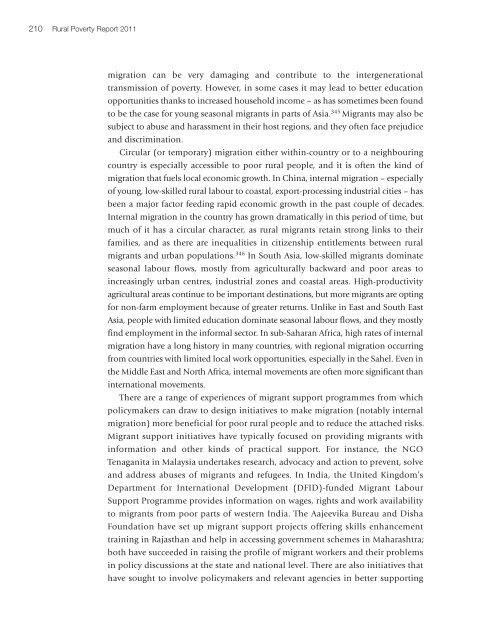English - IFAD
English - IFAD
English - IFAD
Create successful ePaper yourself
Turn your PDF publications into a flip-book with our unique Google optimized e-Paper software.
210<br />
Rural Poverty Report 2011<br />
migration can be very damaging and contribute to the intergenerational<br />
transmission of poverty. However, in some cases it may lead to better education<br />
opportunities thanks to increased household income – as has sometimes been found<br />
to be the case for young seasonal migrants in parts of Asia. 345 Migrants may also be<br />
subject to abuse and harassment in their host regions, and they often face prejudice<br />
and discrimination.<br />
Circular (or temporary) migration either within-country or to a neighbouring<br />
country is especially accessible to poor rural people, and it is often the kind of<br />
migration that fuels local economic growth. In China, internal migration – especially<br />
of young, low-skilled rural labour to coastal, export-processing industrial cities – has<br />
been a major factor feeding rapid economic growth in the past couple of decades.<br />
Internal migration in the country has grown dramatically in this period of time, but<br />
much of it has a circular character, as rural migrants retain strong links to their<br />
families, and as there are inequalities in citizenship entitlements between rural<br />
migrants and urban populations. 346 In South Asia, low-skilled migrants dominate<br />
seasonal labour flows, mostly from agriculturally backward and poor areas to<br />
increasingly urban centres, industrial zones and coastal areas. High-productivity<br />
agricultural areas continue to be important destinations, but more migrants are opting<br />
for non-farm employment because of greater returns. Unlike in East and South East<br />
Asia, people with limited education dominate seasonal labour flows, and they mostly<br />
find employment in the informal sector. In sub-Saharan Africa, high rates of internal<br />
migration have a long history in many countries, with regional migration occurring<br />
from countries with limited local work opportunities, especially in the Sahel. Even in<br />
the Middle East and North Africa, internal movements are often more significant than<br />
international movements.<br />
There are a range of experiences of migrant support programmes from which<br />
policymakers can draw to design initiatives to make migration (notably internal<br />
migration) more beneficial for poor rural people and to reduce the attached risks.<br />
Migrant support initiatives have typically focused on providing migrants with<br />
information and other kinds of practical support. For instance, the NGO<br />
Tenaganita in Malaysia undertakes research, advocacy and action to prevent, solve<br />
and address abuses of migrants and refugees. In India, the United Kingdom’s<br />
Department for International Development (DFID)-funded Migrant Labour<br />
Support Programme provides information on wages, rights and work availability<br />
to migrants from poor parts of western India. The Aajeevika Bureau and Disha<br />
Foundation have set up migrant support projects offering skills enhancement<br />
training in Rajasthan and help in accessing government schemes in Maharashtra;<br />
both have succeeded in raising the profile of migrant workers and their problems<br />
in policy discussions at the state and national level. There are also initiatives that<br />
have sought to involve policymakers and relevant agencies in better supporting

















